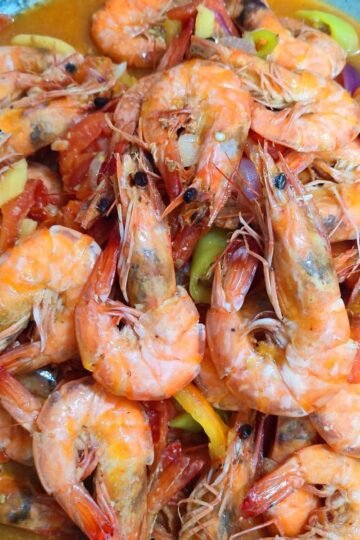Kare-kare is one of my favorite Filipino foods. I remember the first time my Lola Norma made this for me as a kid, I was mesmerized by that rich sauce coating the tender oxtail. Now I make this for my own family, and they love it as well.
I've simplified my recipe because the traditional method with toasting rice grains and grinding peanuts is a lot of work. My recipe gives you that same rich, nutty flavor with ingredients you can easily find in the market.

My Ingredients
For My Main Dish:
- 3 pounds oxtail, cut into serving sizes
- Water for cooking
- 1 banana heart
- 2 large eggplant, cut into 1-inch thick slices
- 1 bundle long beans (sitaw), cut into 3-inch lengths
- 1 bundle pechay, ends trimmed and leaves separated
For My Sauce:
- ¼ cup rice flour
- 1½ tablespoons annatto powder
- ¼ cup peanut butter (unsweetened)
- 1 tablespoon oil
- 1 onion, peeled and sliced thinly
- 5 cloves garlic, peeled and minced
- 2 tablespoons fish sauce (patis)
- Salt and pepper to taste
- Shrimp paste for serving

How I Make My Filipino Kare-kare
- First, I start by rinsing my oxtail under running water and trimming any excess fat with a sharp knife. Then I place the oxtail in a deep pot with enough water to cover it completely.
- I bring the water to a boil over medium heat, making sure to remove any scum that rises to the top. Then I lower the heat, cover the pot, and let it simmer for about 2 to 3 hours.
- While my oxtail is cooking, I prepare my banana heart. I peel away the outer fibrous layers until I reach the tender core. I cut it into quarters and soak it in cold salted water for 15-20 minutes, squeezing it with my hands to release that bitter sap.
- I blanch all my vegetables separately in boiling water. First the banana heart for 1 minute, then the eggplant for 1 minute, the long beans (sitaw) for 1 minute, and finally the pechay for just 30 seconds. I set each aside as I finish blanching them.
- In a dry skillet over medium heat, I toast my rice flour until it becomes lightly browned.
- When my oxtail is tender enough to pierce easily with a fork, I drain it and reserve about 7 cups of that flavorful broth. I combine my toasted rice flour, annatto powder, and 1 cup of the reserved broth, stirring until completely smooth.
- In a large pot, I heat oil over medium heat and saute my onions and garlic. Then I add my oxtail back in and cook until it's lightly browned on all sides.
- I add my fish sauce and cook for 2-3 minutes. Then I pour in the remaining 6 cups of reserved broth and bring everything to a simmer.
- I add my rice flour mixture and peanut butter, stirring constantly to prevent any lumps from forming. I season with salt and pepper and let it simmer for 7-10 minutes until it starts to thicken.
- Finally, I add my blanched vegetables to the pot and cook for just 2-3 minutes until they're heated through. My kare-kare is ready when the sauce coats the back of a spoon and has that golden color.
- Serve and enjoy your kare-kare!

My Personal Tips
- I use a pressure cooker to cut down my cooking time. About 40-45 minutes on high pressure makes the oxtail tender.
- I always toast my rice flour in a dry pan. This makes a difference in flavor.
- When I'm shopping, I ask for "peanut butter na pangkare-kare" at Filipino markets for the best results.
- I never skip the blanching step for vegetables. It keeps them colorful and gives them the perfect texture.
- If my sauce gets too thick, I add warm broth gradually. If it's too thin, I simmer it uncovered to reduce.
- I always serve this with ginisang bagoong. That salty taste is good for balancing the nutty sauce.
Related
Looking for other recipes like this? Try these:

My Filipino Kare-Kare Recipe
My tender oxtail and vegetables in rich peanut sauce that's become our family's favorite Sunday tradition
Ingredients
Method
- First, I start by rinsing my oxtail under running water and trimming any excess fat with a sharp knife. Then I place the oxtail in a deep pot with enough water to cover it completely.
- I bring the water to a boil over medium heat, making sure to remove any scum that rises to the top. Then I lower the heat, cover the pot, and let it simmer for about 2 to 3 hours.
- While my oxtail is cooking, I prepare my banana heart. I peel away the outer fibrous layers until I reach the tender core. I cut it into quarters and soak it in cold salted water for 15-20 minutes, squeezing it with my hands to release that bitter sap.
- I blanch all my vegetables separately in boiling water. First the banana heart for 1 minute, then the eggplant for 1 minute, the long beans (sitaw) for 1 minute, and finally the pechay for just 30 seconds. I set each aside as I finish blanching them.
- In a dry skillet over medium heat, I toast my rice flour until it becomes lightly browned.
- When my oxtail is tender enough to pierce easily with a fork, I drain it and reserve about 7 cups of that flavorful broth. I combine my toasted rice flour, annatto powder, and 1 cup of the reserved broth, stirring until completely smooth.
- In a large pot, I heat oil over medium heat and saute my onions and garlic. Then I add my oxtail back in and cook until it's lightly browned on all sides.
- I add my fish sauce and cook for 2-3 minutes. Then I pour in the remaining 6 cups of reserved broth and bring everything to a simmer.
- I add my rice flour mixture and peanut butter, stirring constantly to prevent any lumps from forming. I season with salt and pepper and let it simmer for 7-10 minutes until it starts to thicken.
- Finally, I add my blanched vegetables to the pot and cook for just 2-3 minutes until they're heated through. My kare-kare is ready when the sauce coats the back of a spoon and has that golden color.
- Serve and enjoy your kare-kare!
Notes
- I use a pressure cooker to cut down my cooking time. About 40-45 minutes on high pressure makes the oxtail tender.
- I always toast my rice flour in a dry pan. This makes a difference in flavor.
- When I'm shopping, I ask for "peanut butter na pangkare-kare" at Filipino markets for the best results.
- I never skip the blanching step for vegetables. It keeps them colorful and gives them the perfect texture.
- If my sauce gets too thick, I add warm broth gradually. If it's too thin, I simmer it uncovered to reduce.
- I always serve this with ginisang bagoong. That salty taste is good for balancing the nutty sauce.
Tried this recipe?Let us know how it was!










Comments
No Comments